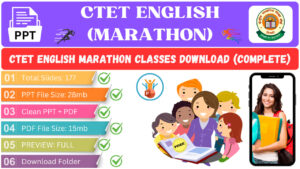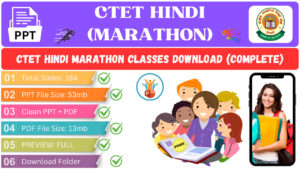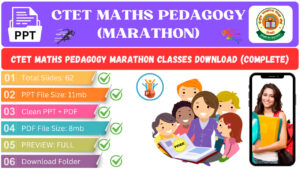CTET Science Marathon Classes PPT Download
Contents
(Complete Slides)
Today we are providing self -made CTET notes, PDF and PPT slides for you, which are available for CTET Science Marathon Classes PPT Download (COMPLETE). The Central Teacher Eligibility Test (CTET) is a national-level examination conducted by the Central Board of Secondary Education (CBSE) in India. It is mandatory for candidates aspiring to become teachers in primary (Classes 1-5) and upper primary (Classes 6-8) schools. Science is a critical subject in the CTET exam, especially for Paper II (for upper primary teachers). This article provides a comprehensive guide to the CTET Science syllabus, important topics, preparation strategies, and study notes to help you excel in the exam.
CTET SCIENCE Marathon Classes
(PPT SLIDES – Part 1)

CTET SCIENCE Marathon Classes
(PPT SLIDES – Part 2)
Important Notes:
- If you are viewing this PPT on your phone, switch to full-screen mode for the best experience. (Tap the 3 dots in the PPT and select “Full Screen.”)
- If you encounter issues while navigating, simply tap on the slide instead of using the “Next” button.
- For an enhanced viewing experience on a PC or laptop, press Ctrl + Shift + F.
CTET Marathon Notes (PPT + PDF) Bundle
(BUY ONLINE)
| Placement / Section | Details / Click To Action Text |
|---|---|
| Title | CTET PPT & PDF Notes (BUNDLE) |
| Number of PPTs / Slides | 10 PPTs + 10 PDFs |
| Delivery Method | Instant Access after Payment (Google Drive Folder) |
| Additional Info | Full Marathon Syllabus Coverage, Study-Friendly PPT Format |
| Copyright / Ownership | Self-made Notes (slideshareppt.net) |
| Payment | Online Gateway – QR, CREDIT CARD, UPI etc… |
| Pricing / Purchase CTA |
Check Price & Buy (Redirects to Pricing Page) |
| Demo Link | View Sample Slides (Click to Open Demo) |
(CTET SCIENCE Self Study Topics)
The Science section in CTET is divided into two parts:
- Content
- Pedagogical Issues
1. Content
The content section focuses on foundational scientific concepts and principles. Key areas include:
- Food:
- Sources of food (e.g., plants, animals)
- Components of food (e.g., carbohydrates, proteins, fats, vitamins, minerals)
- Deficiency diseases
- Materials:
- Types of materials (e.g., natural, synthetic)
- Properties of materials (e.g., hardness, solubility)
- The World of the Living:
- Characteristics of living organisms
- Parts of plants and their functions
- Human body and health
- Moving Things, People, and Ideas:
- Motion and types of motion (e.g., linear, circular)
- Force and friction
- How Things Work:
- Electric current and circuits
- Magnets and magnetism
- Natural Phenomena:
- Weather and climate
- Natural disasters (e.g., earthquakes, floods)
- Natural Resources:
- Conservation of natural resources (e.g., water, forests)
- Renewable and non-renewable resources
2. Pedagogical Issues
This section evaluates your understanding of teaching methodologies and strategies for Science. Key areas include:
- Nature and Structure of Science:
- Scientific method and inquiry
- Role of experimentation and observation
- Approaches to Teaching Science:
- Activity-based learning
- Inquiry-based learning
- Use of experiments and demonstrations
- Teaching-Learning Materials:
- Use of textbooks, charts, and models
- Integration of technology (e.g., educational apps, videos)
- Evaluation in Science:
- Continuous and Comprehensive Evaluation (CCE)
- Formative and summative assessments
- Designing assessment tools (e.g., quizzes, projects)
Also Read: UPSC PPT SLIDES (COMPLETE SERIES)
Important Topics for CTET Science
Here are some key topics to focus on for the CTET Science exam:
- Food and Nutrition:
- Example: Identify the vitamin whose deficiency causes scurvy. (Answer: Vitamin C)
- Materials:
- Example: Which material is used to make electrical wires? (Answer: Copper)
- The World of the Living:
- Example: Name the process by which plants make their food. (Answer: Photosynthesis)
- Motion and Force:
- Example: What type of motion is exhibited by a swinging pendulum? (Answer: Oscillatory motion)
- Electricity and Magnetism:
- Example: What is the unit of electric current? (Answer: Ampere)
- Natural Phenomena:
- Example: What causes earthquakes? (Answer: Movement of tectonic plates)
- Natural Resources:
- Example: Name one renewable source of energy. (Answer: Solar energy)
Preparation Tips for CTET Science
- Understand the Syllabus: Break down the syllabus into smaller sections and create a study plan.
- Focus on Basics: Revise fundamental concepts like food, materials, and motion.
- Practice Problems: Solve a variety of problems to improve your problem-solving skills.
- Use NCERT Books: NCERT textbooks for Classes 6-8 are excellent resources for Science preparation.
- Take Notes: Make concise notes for quick revision.
- Solve Previous Year Papers: Practice past CTET question papers to understand the exam pattern.
- Take Mock Tests: Attempt mock tests to improve time management and accuracy.
CTET Science Study Notes
Here are some concise notes to help you prepare:
- Food and Nutrition:
- Carbohydrates: Provide energy (e.g., rice, bread).
- Proteins: Build and repair tissues (e.g., eggs, meat).
- Vitamins: Essential for health (e.g., Vitamin A for eyesight).
- Materials:
- Natural Materials: Wood, cotton, wool.
- Synthetic Materials: Plastic, nylon, polyester.
- The World of the Living:
- Photosynthesis: Process by which plants make food using sunlight.
- Human Body: Consists of organs like the heart, lungs, and brain.
- Motion and Force:
- Motion: Change in position of an object with time.
- Force: Push or pull that can change the state of motion of an object.
- Electricity and Magnetism:
- Electric Current: Flow of electric charge.
- Magnetism: Property of attracting iron and other magnetic materials.
- Natural Phenomena:
- Weather: Day-to-day conditions of the atmosphere.
- Climate: Average weather conditions over a long period.
- Natural Resources:
- Renewable Resources: Solar energy, wind energy.
- Non-renewable Resources: Coal, petroleum.
Also Read: CTET CDP Marathon Classes PPT Download (COMPLETE)
Conclusion
CTET Science is a crucial subject that tests your scientific knowledge and teaching skills. By understanding the syllabus, focusing on key topics, and practicing regularly, you can excel in this section. Use NCERT books, solve previous year papers, and take mock tests to boost your confidence. With the right preparation, you can crack the CTET Science section and move closer to achieving your dream of becoming a teacher.



